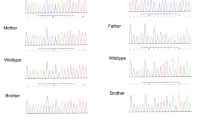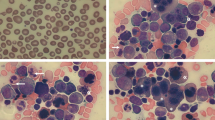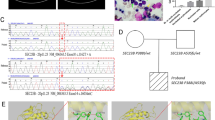Abstract
Congenital dyserythropoietic anemia (CDA) is a heterogeneous group of rare congenital disorders characterized by ineffective erythropoiesis and dysplastic changes in erythroblasts. Diagnosis of CDA is based primarily on the morphology of bone marrow erythroblasts; however, genetic tests have recently become more important. Here, we performed genetic analysis of 10 Japanese patients who had been diagnosed with CDA based on laboratory findings and morphological characteristics. We examined 10 CDA patients via central review of bone marrow morphology and genetic analysis for congenital bone marrow failure syndromes. Sanger sequencing for CDAN1, SEC23B, and KLF1 was performed for all patients. We performed whole-exome sequencing in patients without mutation in these genes. Three patients carried pathogenic CDAN1 mutations, whereas no SEC23B mutations were identified in our cohort. WES unexpectedly identified gene mutations known to cause congenital hemolytic anemia in two patients: canonical G6PD p.Val394Leu mutation and SPTA1 p.Arg28His mutation. Comprehensive genetic analysis is warranted for more effective diagnosis of patients with suspected CDA.

Similar content being viewed by others
References
Heimpel H, Wendt F. Congenital dyserythropoietic anemia with karyorrhexis and multinuclearity of erythroblasts. Helv Med Acta. 1968;34:103–15.
Fujino H, Doisaki S, Park YD, Hama A, Muramatsu H, Kojima S, et al. Congenital dyserythropoietic anemia type 1 with a novel mutation in the CDAN1 gene previously diagnosed as congenital hemolytic anemia. Int J Hematol. 2013;97:650–3.
Iolascon A, Esposito MR, Russo R. Clinical aspects and pathogenesis of congenital dyserythropoietic anemias: from morphology to molecular approach. Haematologica. 2012;97:1786–94.
Ru Y, Liu G, Bai J, Dong S, Nie N, Zhang H, et al. Congenital dyserythropoietic anemia in China: a case report from two families and a review. Ann Hematol. 2014;93:773–7.
Kamiya T, Manabe A. Congenital dyserythropoietic anemia. Int J Hematol. 2010;92:432–8.
Iolascon A, Heimpel H, Wahlin A, Tamary H. Congenital dyserythropoietic anemias: molecular insights and diagnostic approach. Blood. 2013;122:2162–6.
Russo R, Gambale A, Langella C, Andolfo I, Unal S, Iolascon A. Retrospective cohort study of 205 cases with congenital dyserythropoietic anemia type II: definition of clinical and molecular spectrum and identification of new diagnostic scores. Am J Hematol. 2014;89:E169–75.
Kunishima S, Okuno Y, Yoshida K, Shiraishi Y, Sanada M, Muramatsu H, et al. ACTN1 mutations cause congenital macrothrombocytopenia. Am J Hum Genet. 2013;92:431–8.
Richards S, Aziz N, Bale S, Bick D, Das S, Gastier-Foster J, et al. Standards and guidelines for the interpretation of sequence variants: a joint consensus recommendation of the American College of Medical Genetics and Genomics and the Association for Molecular Pathology. Genet Med. 2015;17:405–24.
Dgany O, Avidan N, Delaunay J, Krasnov T, Shalmon L, Shalev H, et al. Congenital dyserythropoietic anemia type I is caused by mutations in codanin-1. Am J Hum Genet. 2002;71:1467–74.
Bianchi P, Schwarz K, Hogel J, Fermo E, Vercellati C, Grosse R, et al. Analysis of a cohort of 101 CDAII patients: description of 24 new molecular variants and genotype–phenotype correlations. Br J Haematol. 2016;175:696–704.
Haija MA, Qian YW, Muthukumar A. Dyserythropoiesis in a child with pyruvate kinase deficiency and coexistent unilateral multicystic dysplastic kidney. Pediatr Blood Cancer. 2014;61:1463–5.
Roy NB, Wilson EA, Henderson S, Wray K, Babbs C, Okoli S, et al. A novel 33-Gene targeted resequencing panel provides accurate, clinical-grade diagnosis and improves patient management for rare inherited anaemias. Br J Haematol. 2016;175:318–30.
Muramatsu H, Okuno Y, Yoshida K, Shiraishi Y, Doisaki S, Narita A, et al. Clinical utility of next-generation sequencing for inherited bone marrow failure syndromes. Genet Med. 2017;19:796–802.
Paw BH, Davidson AJ, Zhou Y, Li R, Pratt SJ, Lee C, et al. Cell-specific mitotic defect and dyserythropoiesis associated with erythroid band 3 deficiency. Nat Genet. 2003;34:59–64.
Bader-Meunier B, Leverger G, Tchernia G, Schischmanoff O, Cynober T, Bernaudin F, et al. Clinical and laboratory manifestations of congenital dyserythropoietic anemia type I in a cohort of French children. J Pediatr Hematol Oncol. 2005;27:416–9.
Baines AJ, Banga JP, Gratzer WB, Linch DC, Huehns ER. Red cell membrane protein anomalies in congenital dyserythropoietic anaemia, type II (HEMP AS). Br J Haematol. 1982;50:563–74.
Iolascon A, Andolfo I, Barcellini W, Corcione F, Garcon L, De Franceschi L, et al. Recommendations regarding splenectomy in hereditary hemolytic anemias. Haematologica. 2017;102:1304–13.
Beutler E, Westwood B, Prchal JT, Vaca G, Bartsocas CS, Baronciani L. New glucose-6-phosphate dehydrogenase mutations from various ethnic groups. Blood 1992;80:255–6.
Garbarz M, Lecomte MC, Feo C, Devaux I, Picat C, Lefebvre C, et al. Hereditary pyropoikilocytosis and elliptocytosis in a white French family with the spectrin alpha I/74 variant related to a CGT to CAT codon change (Arg to His) at position 22 of the spectrin alpha I domain. Blood. 1990;75:1691–8.
Acknowledgements
The authors would like to thank all the clinicians and the patients and families who made this study possible by providing clinical samples. The authors would also like to thank Yoshie Miura, Yuko Imanishi, and Hiroe Namizaki for their valuable assistance. The authors acknowledge the Division for Medical Research Engineering, Nagoya University Graduate School of Medicine for technical support for next-generation sequencing.
Funding
This work was supported by the Research on Measures for Intractable Diseases Project from Ministry of Health, Labor, and Welfare and a Grant-in-Aid from the Ministry of Health, Labor, and Welfare of Japan (H23-TA012).
Author information
Authors and Affiliations
Corresponding author
Ethics declarations
Conflict of interest
The authors declare no competing financial interests.
About this article
Cite this article
Hamada, M., Doisaki, S., Okuno, Y. et al. Whole-exome analysis to detect congenital hemolytic anemia mimicking congenital dyserythropoietic anemia. Int J Hematol 108, 306–311 (2018). https://doi.org/10.1007/s12185-018-2482-7
Received:
Revised:
Accepted:
Published:
Issue Date:
DOI: https://doi.org/10.1007/s12185-018-2482-7




